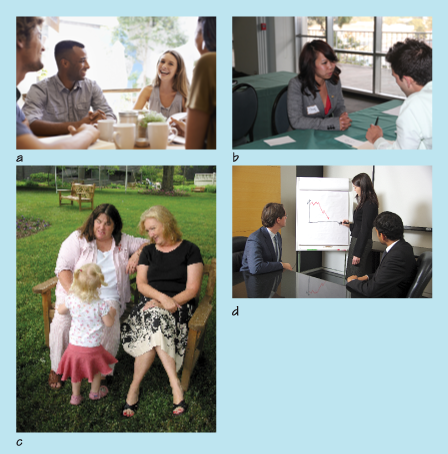1.1 Everyday talk
At home we might talk with our family and friends, at work with colleagues, customers and business partners, and in other environments, such as the bar, restaurant or club, with acquaintances and friends. We are likely to behave and speak differently depending on the context in which we communicate with other people.
In the next activity you will consider the different ways in which people adapt the way they talk with other people to fit different situations.
Activity 1
The pictures below show different contexts where communication happens between people. Consider the likely behaviour and the language used by the people who are involved. Write your thoughts about this in the boxes below, then compare them to mine.
Figure 1a
Answer
a. This picture shows some friends having a drink at a coffee shop. This is an informal situation as can be seen by their relaxed attitude and casual clothes. Their conversation will be spontaneous and may include laughter, jokes and informal language.
Figure 1b
Answer
b. This picture illustrates a job interview. Both participants will typically wear a business suit and behave formally. The conversation will also be more formal. The person being interviewed may have prepared their answers and will carefully choose the language they use, perhaps selecting technical and formal terms to impress the interviewer.
Figure 1c
Answer
c. In this picture, two adults talk with a child at the park. Both adults will probably use simple familiar words and phrases and speak slowly to be understood by the child. They may also change their tone of voice to sound more friendly
Figure 1d
Answer
d. The presenter in this picture is probably addressing a group of colleagues or business partners. The situation calls for formal behaviour and the use of formal language and technical terms. The speaker is likely to have prepared their talk in advance and, to help colleagues follow, they would present a clearly structured talk, supported by diagrams and data.
Comment
This activity shows that the context in which communication takes place affects people’s chosen style. In other words, the physical context, the people and their reasons for talking affect the kind of behaviour and language they choose to adopt. Different behaviour and language could be adopted but would be considered inappropriate. For example the kind of spontaneous, very informal language and tone used between friends at a coffee shop would be inappropriate during a job interview or when talking with a child.

